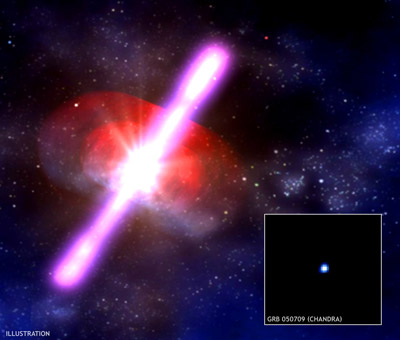Sizzling Remains of a Dead Star: This new view of the historical supernova remnant Cassiopeia A was taken by NASA's Nuclear Spectroscopic Telescope Array, or NuSTAR. Blue indicates where NuSTAR has made the first resolved image ever of this source at the highest energy X-ray light, between 10 and 20 KeV volts. Red and green show the lower end of NuSTAR's energy range, which overlaps with NASA's high-resolution Chandra X-ray Observatory.
Credit: NASA/JPL-Caltech/DSS
But nothing really happens in a straight line. I played soccer professionally, and I served for one year in the military. It was after these experiences that I decided to enroll in a university to study physics (with a concentration on astrophysics). After completion of my master's degree I was fortunate to receive a Fulbright Scholarship, which allowed me to come to the U.S. to work with astronomers at the University of California at Santa Cruz.
Kids often think scientists are these guys from television with funny glasses and white shirts who do the kind of things they have to memorize to pass a test. Scientists don’t do science for the sole reason of creating factoids for textbooks. They’re playing a game just the way the soccer players play a game. But in science, the game has greater impact on society than sports.
I’m a high energy physicist. I work at Clemson University in Clemson, South Carolina, as a Professor in the Astrophysics Department. My focus is on the high energy Universe. You could also call me a gamma-ray astronomer because I look at gamma-ray phenomena in the sky – supernovae and gamma-ray bursts – to make sense of the physical processes that cause them. Supernova explosions produce, together with many other signatures, an observable gamma radiation flux. Gamma rays are generically associated with nuclear phenomena, such as radioactive decays and collisions of ions in exotic environments.
GRB 050709: Gamma-ray bursts longer than two seconds are the most common type and are widely thought to be triggered by the collapse of a massive star into a black hole. As matter falls toward the black hole, some of it forms jets in the opposite direction that move near the speed of light. These jets bore through the collapsing star along its rotational axis and produce a blast of gamma rays after they emerge. Thisartist's rendering depicts a GRB that was discovered on July 9, 2005, by NASA's High-Energy Transient Explorer (HETE).
Credit: X-ray: NASA/CXC/Caltech/D.Fox et al.; Illustration: NASA/D.Berry



